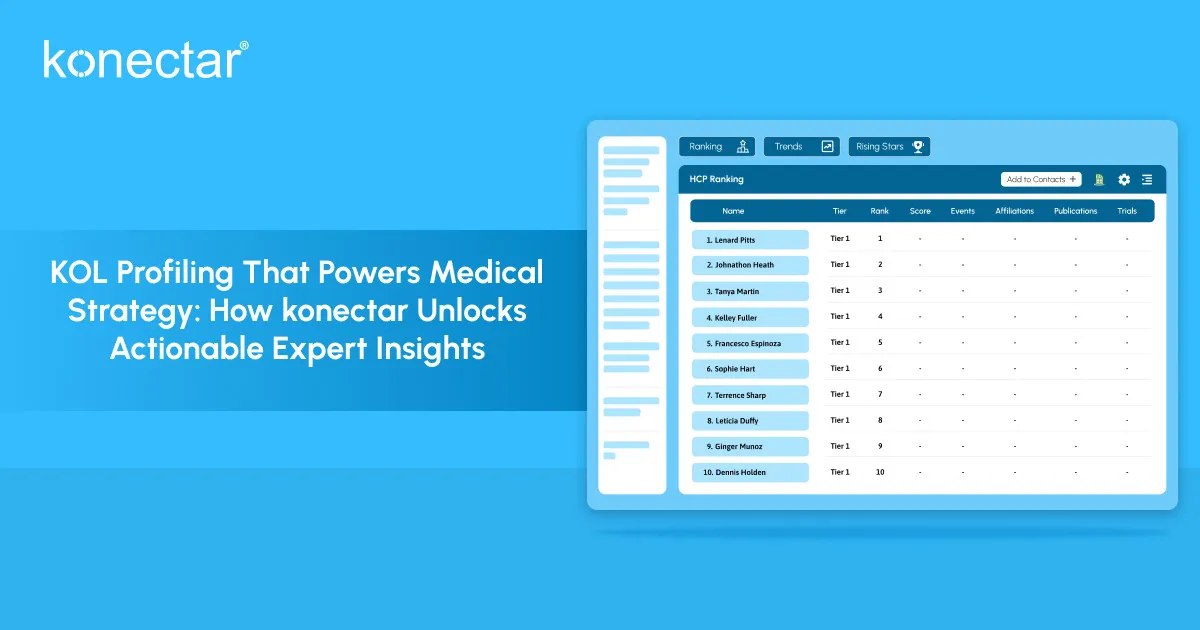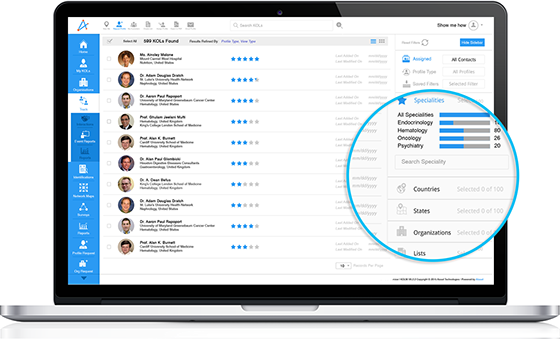25-06-2025
KOL Profiling That Powers Medical Strategy: How konectar Unlocks Actionable Expert Insights

Not every expert is a key opinion leader (KOL), and not every KOL is the right fit. In a market as saturated and specialized as U.S. healthcare, pharma teams need more than a name and a title. They need context. They need clarity. Above all, teams need to be sure their engagement efforts focus on the experts who truly influence medical decisions.
A strong KOL profiling platform helps ensure that these efforts are based on strategic, data-backed insights.
Traditionally, KOL identification focused on high-profile voices—frequent conference speakers, prolific publishers, or established names in academia. But the nature of influence has changed. Now, emerging experts and regional specialists often wield just as much impact.
This shift has given rise to a new imperative: KOL profiling. Rather than asking "who are the most visible experts?" pharma teams are asking, "who are the most relevant?" Profiling is about gaining a contextual understanding of the expert landscape so that every interaction is intentional.
In this article:
- Why KOL Profiling Is Critical for U.S. Medical Affairs
- Unlocking the Value of KOL Profiling with konectar
- Seeing the Bigger Picture
- Closing Remarks
Why KOL Profiling Is Critical for U.S. Medical Affairs
The U.S. healthcare system is shaped by scientific rigor, as well as regional disparities, payer structures, institutional hierarchies, and evolving compliance requirements. Success hinges on the ability to engage experts whose influence is both credible and contextually aligned.
Older KOL lists often miss important context. Profiling helps medical affairs teams go deeper. It shows how an expert fits into the healthcare system, what topics they influence, and where they have the most impact. This insight can guide product messaging and scientific discussions.
Influence in the U.S. healthcare system isn’t one-size-fits-all. A well-known academic may lead national discussions, whereas a regional expert may shape prescribing habits in a single state. Both are important, but in different ways.
KOL profiling helps medical affairs teams understand these differences. It shows where each expert has influence and how that fits into the bigger picture. This makes it easier to plan smarter engagement strategies supported by robust HCP intelligence tools.
U.S. regulations, like the Sunshine Act, add another layer of complexity. Teams need to know who they’re working with, where they’ve interacted before, and how to stay compliant. Profiling helps keep this organized and accurate.
Ultimately, strong KOL engagement relies on sound insights. Profiling provides medical affairs teams with the structure they need to establish expert relationships with clarity and confidence.
Unlocking the Value of KOL Profiling with konectar
An effective KOL profiling platform enables teams to turn scattered data into actionable insights. With konectar, profiling becomes a strategic function that brings context, clarity, and confidence to Medical Affairs teams.
konectar aggregates extensive data from publications, clinical trials, and other sources. This consolidated data helps teams look beyond titles and reputations to surface relevant and impactful experts.
A consolidated view of expert insights
konectar provides a 360° view of profiles that capture an expert’s clinical contributions, publication history, and affiliations. This comprehensive view offers a clear and current understanding of each expert's role.
Early detection of rising voices
With AI-powered discovery, konectar highlights emerging experts. These are individuals who may not yet dominate their fields, but are gaining traction in niche specialties. These are precisely the kind of voices that advanced HCP intelligence tools are designed to uncover.
Intelligent segmentation and filtering
Users can segment experts by therapeutic area, region, research activity, or speaker potential, enabling more targeted, relevant engagement planning across functions. These refined profiles provide timely key opinion leader insights, allowing more precise tailoring of outreach.
Curious to see how konectar enables data-driven profiling to identify the right experts and foster more strategic engagement? Request a live demo today.
Seeing the Bigger Picture
With strong profiling in place, the next step is to strengthen the entire engagement framework.
For many pharma teams, siloed data and fragmented outreach efforts limit the impact of medical engagement. Profiling allows teams to connect the dots between scientific need, field goals, and relationship depth.
When embedded into strategy, profiling improves:
Cross-functional Alignment
Commercial, medical, and clinical teams often touch the same experts. Profiling ensures they share a unified view, avoiding overlap and delivering a better KOL experience. A centralized pharma expert database plays a key role in aligning these touchpoints with consistent information.
Scientific Storytelling
Teams can align messaging with the interests and influence of their expert audiences. This makes communications more relevant, timely, and impactful.
Quality of Insights
When they engage the right experts, teams get better feedback. Profiling helps ensure that input from KOLs is not only credible but also highly applicable to internal decision-making.
Across the industry, leading pharma companies are already moving in this direction. They're investing in context-rich profiling strategies that create stronger connections and drive smarter engagement.
Closing Remarks
Today’s KOL landscape is dynamic. Influence shifts quickly. Voices emerge in unexpected places. Pharma teams can no longer afford to rely solely on visibility. They need a forward-looking KOL profiling platform to surface relevant expertise more quickly and accurately.
As the lines between expertise and reputation continue to blur, KOL profiling will be the competitive edge for teams. And the good news is that profiling doesn’t require overhauling everything. It starts with a mindset—one that values context, clarity, and long-term alignment. From there, tools and strategies can follow.
For teams already adapting to this shift, the rewards are tangible—stronger KOL relationships, more focused engagements, and better strategy outcomes.





